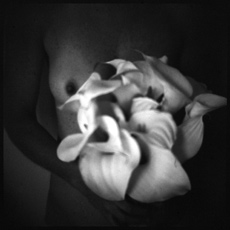
Artists Gallery Fort Mason
Daniel Grant, Rachelle Reichert
Saturday, Mar 8, 2014
3 p.m.
SFMOMA Artists Gallery at Fort Mason
Image: Daniel Grant, Callas, 2011; photo: courtesy the artist
In the photographic series My Affair with Diana, Daniel Grant captures compelling vignettes of women using a Diana: a midcentury plastic camera embraced by contemporary artists for its simplicity of use, expressive results, and iconic square format. He used the same camera while traveling through the United States, Mexico, and Europe and found the photographs it produced favorably unpredictable: alternately crisp, then unfocused; moody, then stunning. These qualities prompted his use of the Diana for this photographic essay on the female form and the symbolic embodiment of the feminine as muse. The bodies he photographs morph from shadowed to brilliant, hard-edged to soft, as the arbitrary focus and pinhole vignettes characteristic of the camera lend at one moment a dramatic chiaroscuro and at another a dreamlike pictorialism. Equating the Diana with a lover, the series title hints at the shifting landscape of intimacy ― and implies that the greatest love affairs are those between artists and their work.
Rachelle Reichert’s large-scale graphite drawings of figures and flowers reference seventeenth-century vanitas painting, Renaissance nudes, Dutch floral painting, and contemporary advertisements, responding to notions of beauty, desire, and the feminine in classical and modern culture. By obscuring and erasing female nudes, often with flowers piled over their heads or encroaching on their bodies from all sides, Reichert alludes to the homogenizing erasure effected by the pursuit of beauty and the fleeting nature of the ideal in the face of inevitable decay and death. Magnifying the material of drawing, Reichert includes abstract explorations of the medium of graphite, a dense form of carbon — essential to all of life, and that which remains after incineration. Seen side by side, her works expand and contract drawing from its traditional forms, moving from highly detailed figure and still-life works to conceptual and formal acts of drawing realized as sculpture, photography, and installation. In this body of work Reichert pushes beyond the edges of drawing to consider perception, materiality, and formation. She reveals elemental qualities of the artist’;s creative process and the corresponding qualities in nature’s cycles of regeneration, perfection, decay, and death.